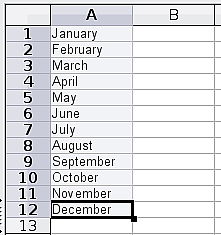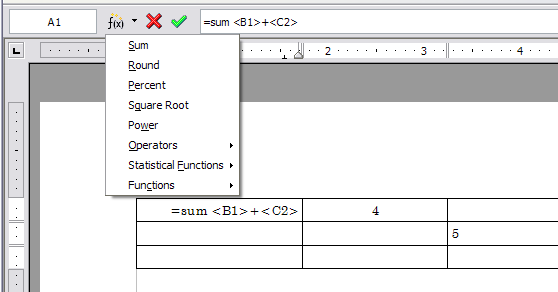

- #Openoffice conditional formatting refer to cell above how to
- #Openoffice conditional formatting refer to cell above update
- #Openoffice conditional formatting refer to cell above manual
- #Openoffice conditional formatting refer to cell above download
Key Point: In Conditional Formatting Rules, absolute references stay the same ($B$1) and relative references (A1) change as Excel applies the formula to each cell in the Applies To range. Column B stays the same (because of the dollar sign in front of the B), but the row changes. This means that for cell C15, the formula would become =($B15=1). When a formula is copied, relative references (no dollar sign) will change. One formula to rule them all! But how does it work?īehind the scenes, Excel is essentially copying this formula to each of the cells in the Applies To range. The formula we are using is =($B6=1), and this applies to all the cells in the range $B$6:$G$30.

The Work Breakdown Structure template shows an example of highlighting an entire row when the value in the Level column is equal to 1. If you want to manually change the fill colors in your table AND highlight every other row, you may need to use the Format as a Table feature in Excel.

You ARE editing the fill color, but you won't see the change because conditional formatting is overriding your format. This means that if you want to change the fill color of a cell in your table, but the conditional formatting rule is already changing the fill color, you won't see the change that you are making.
#Openoffice conditional formatting refer to cell above manual
Key Point: Conditional formatting overrides manual formatting.
#Openoffice conditional formatting refer to cell above update
This technique allows you to insert and copy/paste rows without having to update the background colors manually, but it has one major drawback: conditional formatting overrides manual formatting. Likewise, to highlight every other column, you could use the formula =MOD(COLUMN(),2)=0. Click on Format then select a color in the Fill tab.Select "Use a formula to determine which cells to format.".Go to Home > Conditional Formatting > New Rule.Select the cells you want to format (except the header).Excel is much more flexible and powerful in that respect. In Google Sheets, conditional formatting behaves as though all rules are Stop-If-True. Google Sheets: In Excel, the Number Format, Font Color, Font Style, Font Underline, Font Effects, Fill Color, Fill Effects, Border Color, Border Style, Data Bars, and Icon Sets can be affected independently by different rules. That means that the 4th rule can change the fill color to light red, but it can't override the font color.Įxcel vs.

The first rule does not define a fill color, but it does change the font color. Notice how the red fill color is applied to the HIGH cell. What would happen if I didn't check the Stop-If-True box? Go ahead and try it. That is why the first task row doesn't show a Data Bar in the %Complete column and why the Priority "HIGH" is not highlighted red. With the Stop-If-True box checked, none of the following rules will be evaluated if the condition of that first rule is met. Why do I need to check the Stop-If-True box? This means that you can have one rule that changes a font to gray, a different rule that changes the cell color to red, and a different rule that adds a data bar. ) can be affected independently by different rules. In Excel, the font color and fill color (and border, and font style, and. Key Point #2 means that if the first rule has already changed the font color to gray, the following rules cannot change the font color to green, yellow, or red.
#Openoffice conditional formatting refer to cell above download
I will be using this template to demonstrate some techniques and key facts about conditional formatting, so I would recommend that you download it and experiment with it as you continue to read. The last rule adds a Progress Bar in the % Complete column. The next 3 rules highlight specific text in the Priority column. The first rule changes tasks to gray strike-through when the Done column has a check mark. The image above shows the 5 rules used in the Task Checklist Template. If you are using a template and want to figure out how the conditional formatting works, or want to delete or change rules, you will need to know a couple of things:ġ) To view the rules for selected cells, go to Home > Conditional Formatting > Rules ManagerĢ) To view ALL the rules in the entire worksheet, select "This Worksheet" from the drop-down at the top of the Rules Manager window. Vertex42 has many templates that use both simple and advanced conditional formatting techniques.
#Openoffice conditional formatting refer to cell above how to
How to View/Edit Conditional Formatting Rules


 0 kommentar(er)
0 kommentar(er)
